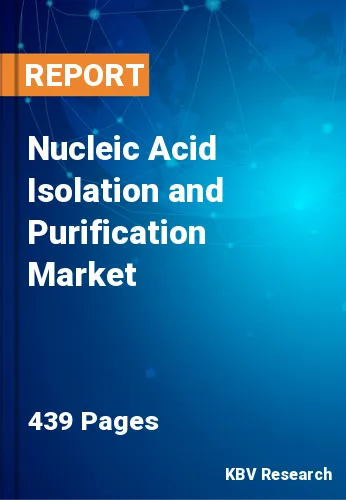The Global Nucleic Acid Isolation and Purification Market size is expected to reach $11.5 billion by 2030, rising at a market growth of 9.2% CAGR during the forecast period.
Circulating nucleic acid isolation and purification are crucial in liquid biopsy techniques, offering non-invasive methods for monitoring diseases, especially cancer. Therefore, the circulating nucleic acid isolation and purification segment captured $862.2 million revenue in the market in 2022. The ability to isolate and purify cfDNA or circRNA from blood samples allows for the detection and monitoring of tumor-related mutations, aiding in early diagnosis, treatment monitoring, and prognostic assessment.
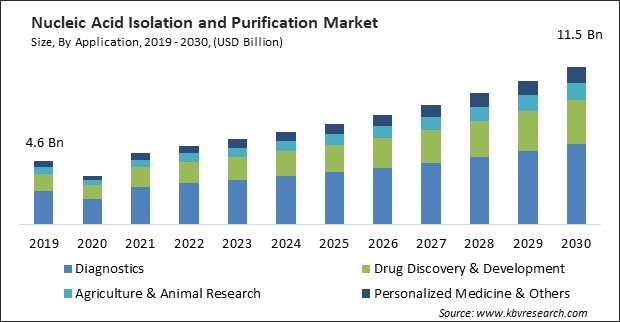
The major strategies followed by the market participants are Product Launches as the key developmental strategy to keep pace with the changing demands of end users. For instance, in October, 2023, Bio-Rad Laboratories, Inc. released two products, PTC Tempo 48/48 and PTC Tempo 384 Thermal Cyclers, to enhance their product portfolio of PCR thermal cyclers. The new products help support PCR applications in process development and in basic and translational research. In September, 2023, Qiagen N.V introduced two products, the QIAwave RNeasy Plus Mini Kit and the QIAwave DNA/RNA Mini Kit, to enhance its QIAwave product portfolio. The new products are more sustainable than the standard kits from Qiagen and offer high-quality performance.
Based on the Analysis presented in the KBV Cardinal matrix; F. Hoffmann-La Roche Ltd. is the forerunner in the market. In February, 2022, F. Hoffmann-La Roche Ltd. introduced the COVID-19 PCR tests like the cobas SARS-CoV-2 Qualitative and the cobas SARS-CoV-2 and Influenza A/B tests to the cobas 5800 System, a molecular laboratory instrument. The new products help to enhance the molecular product portfolio of Roche Diagnostics and offer better performance and strategies for the laboratory testing needs of all volumes. Companies such as Thermo Fisher Scientific, Inc., Danaher Corporation, Merck KGaA are some of the key innovators in market.
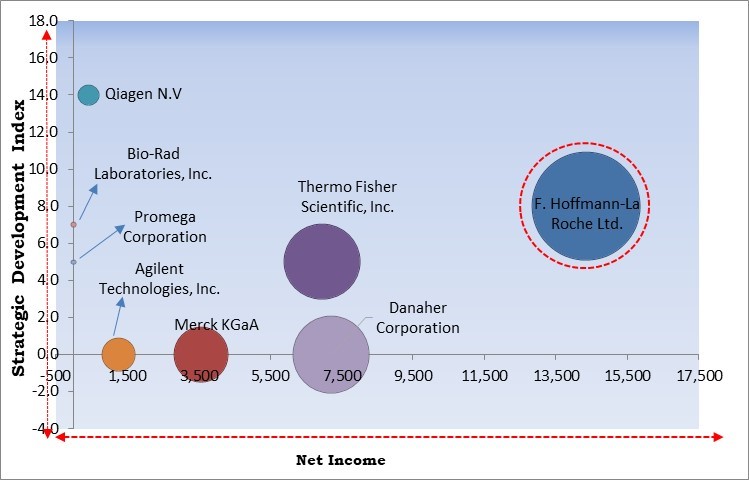
Genomics involves the study of an organism's complete DNA sequence and how it functions. With the advent of high-throughput sequencing technologies (next-generation sequencing - NGS), there's been a massive surge in genomics research. These are essential steps in sequencing and analyzing the vast amounts of genetic data obtained, thus driving the need for efficient and reliable isolation and purification techniques. Furthermore, customized medicine entails adapting medical therapy to each patient's unique traits. This includes utilizing an individual's genetic information to select the most suitable treatment. Nucleic acid isolation and purification are fundamental steps in extracting and analyzing an individual's genetic material, enabling the development of targeted therapies, diagnostics, and treatment plans. These factors will drive the growth in the market.
Modern technologies have streamlined these processes, reducing manual intervention and human error. Automated systems, magnetic bead-based methods, and silica membrane-based purification have significantly improved efficiency, enabling higher throughput and faster processing of samples. Advanced methodologies, such as rapid kits and automated systems, have drastically reduced the time required for nucleic acid isolation and purification. Furthermore, the miniaturization of devices and the development of high-throughput platforms allow the simultaneous processing of multiple samples, significantly increasing the throughput capacity while maintaining quality and precision. Integrating nucleic acid isolation and purification techniques with other technologies, such as sequencing, PCR, microarray analysis, and CRISPR-based applications, has streamlined workflows, providing a seamless transition between various steps in these processes. These aspects will help accelerate the growth of the market.
Smaller laboratories or research facilities with limited budgets may find it challenging to allocate a significant portion of their funds to purchase high-quality equipment. Due to budget constraints, some smaller laboratories may be unable to afford the latest and most efficient technologies. This can limit the quality and quantity of their research, potentially hampering their competitiveness and ability to secure research grants or collaborations. In addition to the initial investment, ongoing operational costs for consumables, maintenance, and skilled personnel can be substantial. Smaller labs with budget constraints may struggle to maintain these systems efficiently, leading to lower quality and throughput. Smaller laboratories may find it challenging to keep up with these innovations as they lack the resources to invest in new equipment and training. These factors will limit the growth in the market.
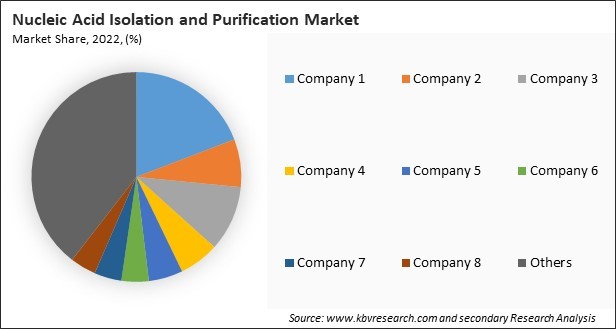
The leading players in the market are competing with diverse innovative offerings to remain competitive in the market. The above illustration shows the percentage of revenue shared by some of the leading companies in the market. The leading players of the market are adopting various strategies in order to cater demand coming from the different industries. The key developmental strategies in the market are Product Launches and Product Expansions.
Based on application, the market is divided into diagnostics, drug discovery & development, personalized medicine, agriculture & animal research, and others. The diagnostics segment recorded the maximum revenue share in the market in 2022. Molecular diagnostic tests, which rely on this, are increasingly being used for disease detection, monitoring, and treatment decisions. This includes applications in infectious disease testing, cancer diagnostics, genetic testing, and other areas. Ongoing technological advancements in these methods have made these processes more efficient, accurate, and faster.
Based on product, the market is segmented into kits, reagents, and instruments. In 2022, the instruments segment garnered a significant revenue share in the market. The demand for automated systems that can handle high sample volumes efficiently has significantly boosted the growth of instruments in this sector. These systems streamline this process, reducing human intervention and minimizing the chances of errors. Innovations in instrument design and functionality have played a crucial role in the market's growth.
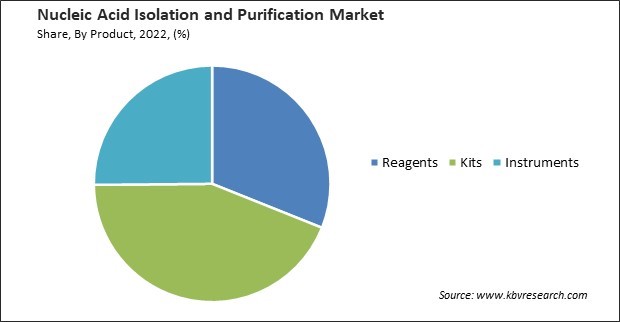
On the basis of method, the market is divided into column based, magnetic beads, reagent based, and others. In 2022, the magnetic beads segment witnessed the maximum revenue share in the market. Magnetic bead-based isolation methods offer high efficiency in capturing nucleic acids from samples. These beads are functionalized with coatings that specifically bind nucleic acids, enabling highly selective extraction resulting in pure yields of DNA or RNA. The magnetic bead-based methods are highly amenable to automation and high-throughput processing, making them ideal for handling large volumes of samples simultaneously.
By type, the market is divided into plasmid DNA isolation & purification, total RNA isolation & purification, circulating nucleic acid isolation & purification, genomic DNA isolation & purification, messenger RNA isolation & purification, microRNA isolation & purification, and others. In 2022, the total RNA isolation and purification segment witnessed a promising revenue share in the market. The growing emphasis on understanding gene expression and regulation in molecular biology has driven the demand for high-quality RNA. Researchers require pure RNA samples for various applications, including gene expression studies, RNA sequencing, microarray analysis, and other molecular biology techniques. Thus, the segment will proliferate in the upcoming years.
On the basis of end user, the market is segmented into hospitals & diagnostic centres, academic research institutes, pharmaceutical & biotechnology companies, contract research organizations, and others. The hospitals and diagnostic centres segment held the largest revenue share in the market in 2022. Hospitals and diagnostic centres are increasingly incorporating molecular diagnostics into their services. This involves using these techniques to identify pathogens, genetic disorders, and various diseases. These facilities are adopting advanced technologies to provide accurate and quick diagnostic results.
| Report Attribute | Details |
|---|---|
| Market size value in 2022 | USD 5.8 Billion |
| Market size forecast in 2030 | USD 11.5 Billion |
| Base Year | 2022 |
| Historical Period | 2019 to 2021 |
| Forecast Period | 2023 to 2030 |
| Revenue Growth Rate | CAGR of 9.2% from 2023 to 2030 |
| Number of Pages | 439 |
| Number of Table | 613 |
| Report coverage | Market Trends, Revenue Estimation and Forecast, Segmentation Analysis, Regional and Country Breakdown, Competitive Landscape, Market Share Analysis, Porter’s 5 Forces Analysis, Company Profiling, Companies Strategic Developments, SWOT Analysis, Winning Imperatives |
| Segments covered | Type, Product, Method, Application, End User, Region |
| Country scope |
|
| Companies Included | Thermo Fisher Scientific, Inc., Qiagen N.V., F. Hoffmann-La Roche Ltd., Merck KGaA, Promega Corporation, Agilent Technologies, Inc., Danaher Corporation, Bio-Rad laboratories, Inc., Illumina, Inc., and New England Biolabs, Inc. |
| Growth Drivers |
|
| Restraints |
|
By region, the market is segmented into North America, Europe, Asia Pacific, and LAMEA. The North America segment procured the highest revenue share in the market in 2022. North America is a hub for technological innovation in the life sciences and biotechnology sectors. Significant investments in research and development have led to the continuous evolution of these techniques. Advanced methods, automation, and high-throughput technologies are being developed and adopted, enhancing the efficiency and precision of these processes.
Free Valuable Insights: Global Nucleic Acid Isolation and Purification Market size to reach USD 11.5 Billion by 2030
The market research report covers the analysis of key stake holders of the market. Key companies profiled in the report include Thermo Fisher Scientific, Inc., Qiagen N.V., F. Hoffmann-La Roche Ltd., Merck KGaA, Promega Corporation, Agilent Technologies, Inc., Danaher Corporation, Bio-Rad laboratories, Inc., Illumina, Inc., and New England Biolabs, Inc.
By Application
By Product
By Method
By Type
By End User
By Geography
This Market size is expected to reach $11.5 billion by 2030.
Increasing R&D in Genomics, Molecular Biology, and Personalized Medicine are driving the Market in coming years, however, High Initial Investments restraints the growth of the Market.
Thermo Fisher Scientific, Inc., Qiagen N.V., F. Hoffmann-La Roche Ltd., Merck KGaA, Promega Corporation, Agilent Technologies, Inc., Danaher Corporation, Bio-Rad laboratories, Inc., Illumina, Inc., and New England Biolabs, Inc.
The expected CAGR of this Market is 9.2% from 2023 to 2030.
The Kits segment is registering maximum revenue in the Market by Product in 2022;there by, achieving a market value of $4.8 billion by 2030.
The North America region is leading the segment in the Market by Region in 2022 and would continue to be a dominant market till 2030;there by, achieving a market value of $4.2 billion by 2030.
Our team of dedicated experts can provide you with attractive expansion opportunities for your business.
